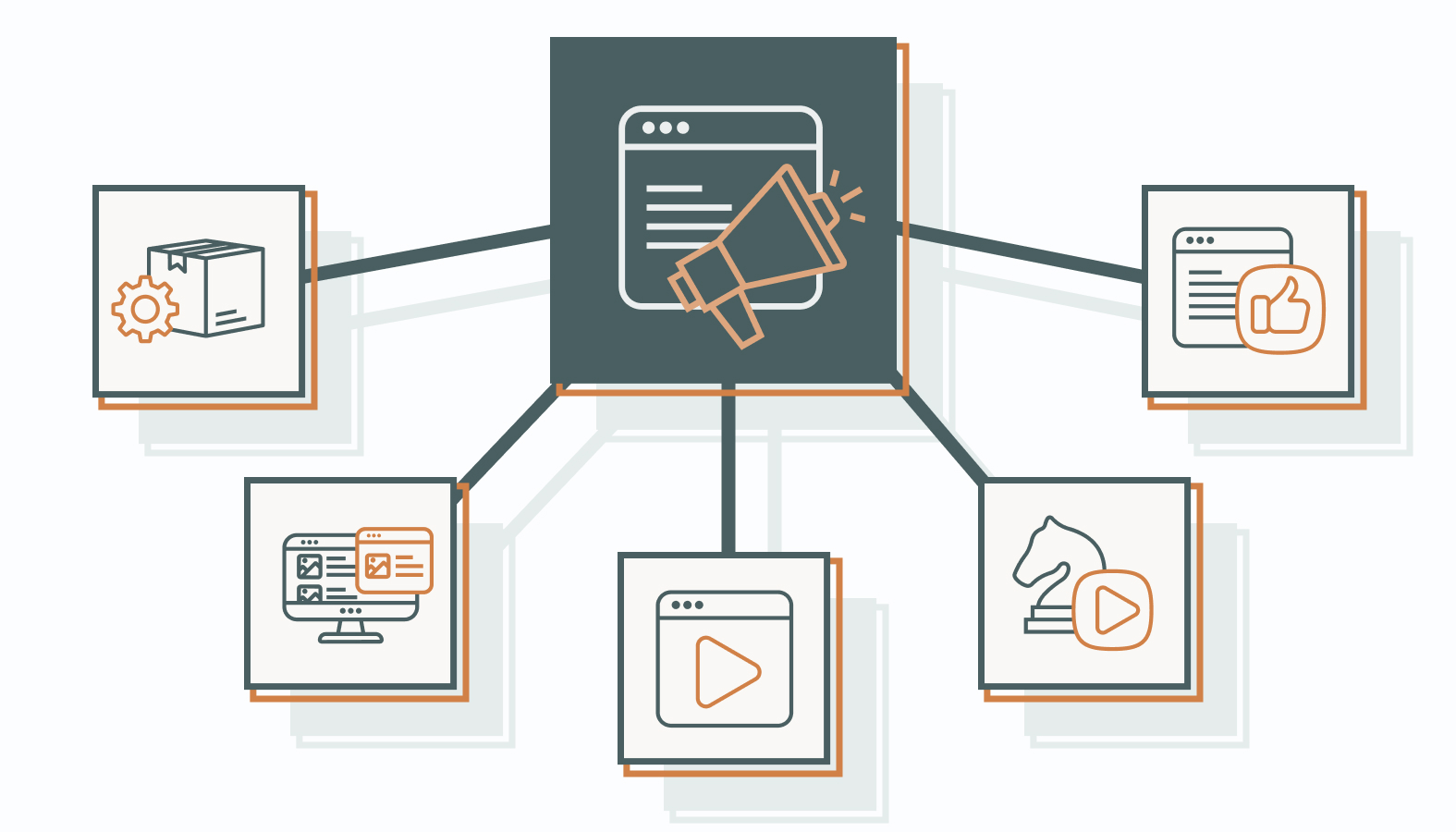In the world of ecommerce, having a stellar product isn’t enough. Attention is the new currency, and content is how you earn it.
While many brands invest heavily in ads and polished interfaces, they often overlook the content that actually moves customers forward. Customers don’t just buy products—they buy clarity, confidence, and connection. That’s where content plays a critical role.
Ecommerce content marketing informs, reassures, and persuades. It answers questions before they’re asked, removes friction, and builds trust long before checkout. If growth has stalled or engagement feels shallow, the problem isn’t visibility; it’s connection.
The right content strategy bridges that gap. It turns content into a true sales asset—designed to convert, not just decorate.
What is Content Marketing? (And Why It Matters for Ecommerce)
Content marketing drives scalable, sustainable ecommerce growth. It positions your brand as more than a transaction.
Instead of interrupting with sales pitches, it earns attention by offering something valuable—insight, entertainment, or answers—on the customer’s terms.
Content marketing is the disciplined creation and distribution of high-quality, relevant material that attracts your target audience and motivates action. That might mean a sign-up, a purchase, a share, or a return visit.
What sets it apart is that it creates value for both sides. Great content solves real problems or sparks curiosity while naturally guiding the audience toward your solution.
For ecommerce brands, this approach delivers results across the customer journey:
- Attracts traffic
- Builds trust
- Increases conversions
And it does all that without relying solely on paid ads. But success takes more than content volume. Strategy is what makes it work.
Essential Content Types for Every Ecommerce Business
Strong content doesn’t just fill space—it drives demand, builds trust, and converts traffic into revenue. The most effective ecommerce brands focus on formats that move the needle.
Product Descriptions to Inform & Convert
Dry, spec-driven descriptions leave money on the table.
Every word should reinforce value. A strong description highlights pain points, showcases benefits, and clearly depicts life after purchase. Use sensory language. Anticipate objections. Close the gap between curiosity and checkout.
The goal is to make the buyer feel like they’ve experienced the product before they click “Add to Cart.”
Blog Posts that Build Authority & Drive Organic Growth
Blogs aren’t for checking SEO boxes. They’re among the highest-ROI content assets you can create when done right.
They’re where you solve problems, share expertise, and prove you understand your customer better than anyone else. That’s how trust builds.
They’re also long-term traffic engines. Search-optimized posts attract suitable visitors and keep your site sticky. Unlike ads, content equity compounds over time. The more helpful your blog us, the more magnetic your brand becomes.
User-Generated Content (UGC) That Builds Trust on Autopilot
People trust other customers more than they trust brands. UGC taps into that with raw and relatable reviews, unboxings, tagged photos, or video testimonials.
Encourage customers to share. Offer simple incentives, promote branded hashtags, and feature standout content on product pages, emails, and social.
This isn’t just proof—it’s participation. UGC invites customers into the brand experience and makes your business feel human.
Videos That Sell Without Saying a Word
Effective videos don’t rely on narration or sales talk. They rely on clarity. They show how the product works, solves a problem or fits into the customer’s life.
A great video answers common objections without needing a voiceover to say, “Trust us.”
From tutorials and demos to behind-the-scenes footage, video drives engagement. Once optimized for search or social media, it keeps works long after publication.
Social Media Content That Fuels Connection
Social isn’t a megaphone; it’s your handshake. It’s where your brand builds familiarity and trust.
The brands that thrive on social posts with purpose: helpful tips, product walkthroughs, authentic stories, and actual conversations in the comments. Skip the fluff. Focus on relevance.
Every post should either educate, entertain, or engage. That’s how you stop the scroll and start building loyalty.
How to Create High-Performing Ecommerce Content (The Core Skills)
Engaging content is essential in ecommerce. It must capture attention, drive interaction, and build lasting loyalty to stand out in a crowded digital market.
Content Creation Best Practices
To maximize impact, content must align with your audience’s needs and business goals. When it resonates, it drives engagement and conversions.
1) Understanding Your Audience
Crafting compelling content starts with understanding who you’re speaking to. Dive into demographic data, collect customer feedback, and use analytics tools to uncover behavior and preferences. These insights inform your content strategy, helping you shape messaging and formats that match what your audience wants and expects.
2) Crafting Compelling Headlines and Introductions
Your headlines and introductions are the velvet rope to your content. They determine whether someone reads on or scrolls past. Make them clear, relevant, and emotionally resonant. Use strong language, compelling questions, or benefits that immediately capture interest.
3) Optimizing Content for SEO
SEO (search engine optimization) ensures your content gets seen.
Start with keyword research to understand what your audience is searching for. Then, implement on-page SEO tactics like meta tag optimization, structured headers, and image alt text.
Build backlinks to boost authority. These steps increase your content’s discoverability and organic performance.
4) Maintaining Consistency Across Platforms
A consistent brand voice and message across all your content platforms is essential for building a cohesive brand identity. A unified content strategy ensures uniformity in style, tone, and messaging, reinforcing brand recognition and trust.
Develop a comprehensive content style guide to maintain consistency and coordinate cross-platform publishing schedules to ensure your messages are perfectly aligned and timely.
5) Master Conversion-Focused Copywriting
Traffic is meaningless if your copy doesn’t convert. High-impact content meets user intent and inspires action.
Effective ecommerce copy turns interest into action by:
- Leading with benefits: “Soft, breathable comfort” is more persuasive than “100% cotton.”
- Using social proof: Reviews and testimonials quickly build trust.
- Creating urgency (without hype): If stock is limited or a shipping deadline looms, say so—clearly.
- Formatting for scanning: Use bullets, bolded takeaways, and short sentences for easy reading.
- Sounding human: Skip the jargon and brochure language. Speak like a helpful friend guiding someone toward the right purchase.
Content Funnels: Mapping Content to the Buyer Journey
To increase performance, connect each piece of content to a stage in the buyer journey. Think of content as a sophisticated system, not just a random collection of individual pieces.
- Top of Funnel (Awareness): Use blogs, social posts, and how-to guides to educate and entertain. The goal is to reach new audiences and provide value, not to sell yet.
- Middle of Funnel (Consideration): Now’s the time for comparison guides, reviews, and detailed blog posts highlighting why your solution stands out.
- Bottom of Funnel (Conversion): Remove final doubts with optimized product pages, strong FAQs, reviews, demos, and clear return policies.
When your content matches where the buyer is, it nudges them forward with purpose.
Implementing and Managing Your Content Strategy (Getting Organized & Maximizing Reach)
Strong content management boosts productivity and improves the customer experience. When your processes are organized, messaging becomes more consistent and impactful.
Manage and Scale Your Content With the Right Systems
A Content Management System (CMS) is the backbone of efficient content operations. It streamlines creation, management, and publication, ensuring everything runs like a well-oiled machine.
Centralized Content Management
A CMS provides a centralized hub for all your content assets. This dramatically reduces duplication and squashes errors before they even appear.
With a single platform managing diverse content types and formats, you guarantee consistency and cohesion across every digital touchpoint. This centralization simplifies updates and maintenance, saving valuable time and resources you’d rather spend innovating.
User Accessibility
One of the standout features of a robust CMS is its ability to grant tiered access to various team members. This enhances both security and efficiency.
Intuitive user interfaces are non-negotiable; they empower non-technical staff to manage content remarkably easily. This accessibility democratizes content management, allowing more of your team to contribute without needing a computer science degree.
Collaboration and Workflow Features
A CMS acts as your team’s ultimate collaboration tool, offering features for feedback loops, version control, and streamlined approvals. These functionalities sharpen communication, ensuring everyone is perfectly aligned. This enhances content quality and maintains consistency.
Furthermore, robust workflow management features guarantee timely publication, helping you maintain a consistent content schedule that resonates deeply with your audience.
SEO Optimization Tools
Many CMS platforms arrive pre-equipped with built-in SEO tools. These aren’t just gadgets; they’re critical for optimizing your content for search engines. They assist with keyword integration, meta tag management, and performance tracking, ensuring your content is engaging and easily discoverable.
Leveraging these tools significantly improves your search engine rankings and attracts more high-value organic traffic.
Build a Social Media Strategy That Supports Ecommerce Growth
A precisely crafted social media strategy isn’t just an accessory; it amplifies your overall content marketing efforts. It’s how you reach and engage your audience with maximum effectiveness.
Define Clear Objectives
You need clear, measurable objectives for your social media campaigns.
Whether targeting brand awareness, lead generation, or customer engagement, aligning these objectives with your broader business goals ensures a cohesive strategy. Clear objectives provide direction and allow you to measure success with absolute precision.
Audience Analysis
Effective social media starts with knowing exactly who you’re talking to.
Go beyond surface-level demographics and dig into psychographics: what your audience values, how they behave, and why they engage. The more precise your audience insights, the sharper your content becomes.
When you understand what matters to them, you can craft messaging that lands with relevance and builds real connections.
Platform Selection
Not every platform deserves your energy. Each one has distinct advantages depending on your audience and content type.
- Visually rich products? Instagram is your stage.
- Selling into the enterprise? LinkedIn is your boardroom.
The goal isn’t to be everywhere. It’s to be where your audience is most active and receptive. Choose your platforms strategically to maximize both visibility and impact.
Content Planning
Consistency wins attention. A structured content calendar keeps your posting rhythm steady and strategic. It’s more than scheduling; it’s about balancing promotional pushes with content that educates, entertains, or solves problems.
With the right cadence and mix, your brand stays top-of-mind without wearing out its welcome.
Email Marketing as a Content Channel
Email isn’t just for receipts and promotions—it’s one of the most powerful, underutilized content channels in ecommerce. Every message is an opportunity to build trust and drive revenue.
Here’s how to make email work harder:
- Welcome Series: Immediately introduce your brand story and showcase your best products. Set expectations and build early momentum.
- Abandoned Cart Flows: Recover lost sales by addressing objections, reminding customers of what they left behind, and creating urgency with low-stock or shipping deadline alerts.
- Post-Purchase Sequences: Upsell complementary products, educate customers on using what they bought, and ask for reviews to fuel social proof.
- Value-Driven Newsletters: Go beyond promos. Share user-generated content, new blog posts, behind-the-scenes updates, product tips, or community spotlights.
Why focus on email?
- It’s permission-based, meaning your audience wants to hear from you.
- It drives higher engagement than most other channels.
- It delivers exceptional ROI, especially when personalized and aligned with your broader content strategy.
If you invest in blogs and social content but neglect email, you’re leaving serious revenue on the table. Treat it as both a key distribution engine and a relationship-building powerhouse.
Advanced Tactics for Boosting Your Content’s Impact
In ecommerce, advanced content marketing tactics are key to standing out and connecting meaningfully with modern consumers. These strategies amplify visibility and deepen customer relationships to drive loyalty and sales.
Personalization and Customer Experience
Personalized content builds stronger connections by speaking directly to individual needs and preferences.
-
- Leveraging Data for Personalized Content: Customer data—past behaviors, browsing history, purchase preferences—is a powerful resource for crafting tailored experiences. Analyzing this data enables content that feels relevant and personal. Always ensure ethical use, prioritize privacy, and protect audience trust.
- Creating Customer-Centric Content Strategies: Effective strategies are aligned with the customer journey. Match content to each stage—awareness, consideration, decision—to ensure relevance. Focusing on your audience’s values increases meaningful interactions and drives engagement.
- Using Personalization Tools and Technologies: Tools like CRMs and personalization platforms streamline how you tailor content. Choose solutions that integrate smoothly into existing workflows to enhance, not complicate, your strategy.
- Measuring the Impact of Personalization on Engagement: Track KPIs (key performance indicators) and engagement metrics to evaluate effectiveness and refine personalization efforts. Data insights reveal what resonates and help you optimize future content.
Repurposing & Scaling Your Content
Creating new content constantly is unsustainable. The most efficient teams repurpose what works.
Start with a strong asset—like a blog post—and transform it into other formats:
- Pull quotes or stats for social carousels.
- Turn highlights into short-form video.
- Use the intro or CTA as an email teaser.
- Reframe for a LinkedIn post with a unique angle.
- Expand into a downloadable guide or webinar.
This multiplies your reach and meets people where they are—whether they read, watch, or scroll.
Here’s a simple repurposing framework to live by:
- Identify core ideas
- Slice into various formats
- Match to platforms
- Schedule staggered release
Treat content like a scalable system, not a series of one-off tasks. That’s how you maintain momentum without burning out your team or budget.
AI & Tools for Smarter Content Creation
Technology speeds up creativity without replacing it.
Modern content teams rely on innovative tools to ideate, optimize, and execute:
- AI tools like ChatGPT or Jasper for outlines, headlines, and rewrites
- SEO tools like SurferSEO, Ahrefs, and SEMrush for research and optimization
- CMS platforms like Shopify, WordPress, and Storyblok for asset management
- Analytics tools like Google Analytics and Hotjar to track behavior
- Personalization tools like Klaviyo and Optimizely for tailored messaging
Choose tools that save time, integrate cleanly, and support your strategy. But remember: your understanding of the customer is still your most powerful advantage.
Addressing Common Challenges in Ecommerce Content Marketing
Every content team faces roadblocks. The difference between stagnant and standout brands lies in how you solve them.
Here’s how to tackle the three most common issues:
1) Content Saturation
The challenge: Your audience is overwhelmed. Endless blog posts, ads, and videos make it hard for your content to stand out.
How to overcome it:
- Narrow your focus. Target niche topics that speak to specific segments of your audience.
- Bring a unique voice. Share a strong perspective or fresh take to differentiate your message.
- Switch up the format. Use interactive infographics, podcasts, or short-form videos to break through the noise.
The goal: Be memorable, not just present.
2) Content Inconsistencies
The challenge: Inconsistent voice, visuals, or publishing cadence confuse your audience and weaken your brand identity.
How to fix it:
- Create a style guide. Define voice, tone, brand vocabulary, and visual elements.
- Sync your schedule. Coordinate cross-platform publishing to reinforce consistent messaging.
- Use one source of truth. Centralize planning in a content calendar or project management tool.
The goal: Make your brand instantly recognizable everywhere.
3) Misaligned or Off-Brand Content
The challenge: When content drifts from your brand identity, it erodes trust and confuses your message.
How to realign:
- Audit regularly. Review your existing content to spot gaps or inconsistencies.
- Train your team. Ensure everyone understands how to apply the brand guidelines.
- Embed the brand. Weave your values, tone, and visual identity into every piece of content.
The goal: Build credibility with a consistent, clear brand voice your audience can trust.
4) Content Performance Gaps
The challenge: You’re creating content, but is it actually working? Without the right metrics, it’s impossible to know what’s resonating, what’s converting, or where you’re losing people. Guesswork leads to wasted effort and missed opportunities.
How to track performance:
- Start with meaningful metrics. Go beyond surface-level numbers. Track:
- Traffic – Are people finding your content?
- Time on Page & Bounce Rate – Are they staying or bouncing?
- Click-Through Rate (CTR) – Are they taking the next step?
- Assisted Conversions – Is content nudging them toward a purchase?
- Scroll Depth & Engagement – Are they truly interacting?
- Use the right tools. Platforms like GA4, Hotjar, and HubSpot can uncover what’s working and highlight drop-off points.
- Set and review KPIs. Tie content goals to business goals. Track consistently and adjust based on what the data shows.
The goal: Make every piece of content work harder by backing creative decisions with data. When you measure what matters, you don’t just create; you convert.
Make Content Your Competitive Edge
Ecommerce content marketing isn’t about publishing for the sake of it. It’s about building a system that attracts the right people, converts them into customers, and keeps them coming back.
Start by understanding exactly who you’re targeting.
- Use data to identify what they want, what they hesitate over, and what drives them to buy.
- Create content that speaks to those triggers consistently across every channel.
- Integrate tactics like personalization, SEO at scale, and social proof to increase performance without increasing effort.
And remember: the strategy isn’t set-and-forget. It’s a living, evolving framework. The brands that win are the ones that refine constantly: tracking what works, tossing what doesn’t, and always staying one step ahead of customer behavior.
Ultimately, ecommerce content marketing done right builds authority, drives revenue, and deepens loyalty. It’s a long-term asset that compounds value over time.
Let’s Turn Strategy Into Revenue
You’ve got the blueprint. Now, implement it with focus and scale.
If you’re looking to grow with content but aren’t sure where to start, let’s talk. No pressure, no pitch deck — just a casual, focused chat about your goals and how we can help you hit them faster.
Schedule a candid conversation with one of our experts.» Let’s build a content engine that actually delivers.










